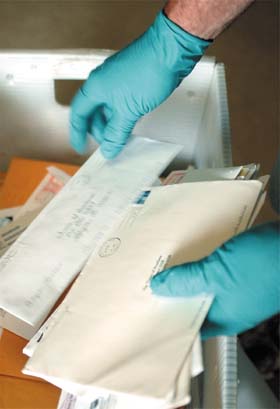


The Threat of a Threat

STORY BY: Nick Pittman
PHOTO by Terri Fensel
"I really hope, that in the community, that maybe this is a positive thing," says Craig Noel of Argus Security. What he refers to as a "positive thing" - surprisingly enough - is the rash of hoax letters that flooded Lafayette residences and businesses, such as Argus, April 19.
On that day some 200 letters arrived at destinations throughout town and even as far away as Baton Rouge and San Antonio, Texas. The letters, printed with a font that resembled handwriting, promised that 25 bombs would detonate April 27 during the height of Festival International de Louisiane. Some letters were also coated in a powdery substance that has since tested negative for anthrax. The letters also pinned responsibility on someone or something called "the Brothers" and contained two lines of Hebrew and Arabic writing.
Once translated, the mishmash of letters and accents broke down into meaningless gibberish. According to a translator, "I suppose the one who wrote these two lines knows very little Arabic and (they) didn't even come up with one single word."
No arrests have been made in the case, but U.S. Attorney Donald Washington recently announced that his office is closing in on two suspects. However, the office would not divulge if the suspects matched the FBI profile previously given of "a loner with no friends."
Asked if he thought this incident might slip Lafayette into a "Boy Who Cried Wolf" syndrome, Noel states that he thinks it was an eye-opening experience and, "probably helped our readiness ... even though we were on a higher caution level, it even heightened that." With Vice President Dick Cheney's recent comments that another attack is "not a matter of if, but when," it is definitely a question worth asking.
The Times posed the same question to local authorities - does a false alarm like this hurt our readiness?
"Well, I think it affects our readiness. I think what it does is it sharpens our readiness," says Cpl. Mark Francis of the Lafayette Police Department. "The more you do something the better you get at it."
Although, in the months following Sept. 11, patrols have been stepped up in some vital areas of the city, and extra security has been brought in to guard electrical and water facilities, Francis does not see Lafayette as a target. He blames the hoax on "local folks pretty much trying to mirror what's going on around the world ... trying to take matters into their hands to make a point."
Another authority who shares Francis' sentiments is Trent Strasburg of the Louisiana district of the U.S. Postal Inspectors. The inspectors are brought in whenever the mail is used to violate laws - be it pipe bombs or pornography.
"It is one thing to sit back and have meetings and say we are going to do this and do that," says Strasburg. "But, when the group actually has to respond, not knowing if it is real or not, then we see how effective it is going to be. From that standpoint I think it was an improvement. All that came together real well and certainly showed us what we were doing right and what we can do better next time."
Since the letters scare, little has changed in Lafayette post offices. Troy Southerland, Lafayette's postmaster, says that his post offices were already taking the necessary precautions with the mail stream. However, he does admit that, unless there is a spill, it is hard to catch something like fake anthrax in the half million pieces of mail that travel through Lafayette every day.
"We, like every other post office, are taking much precaution," says Southerland. "However, they (Lafayette citizens) are entitled to delivery service whether they are the person sending or receiving, and we are going to provide that service."
Although these officials tout this incident as a great training exercise, it did not come without great costs.
On Oct. 30, 2001, Katherine Howard didn't feel like missing her child's birthday party to go in to work at the Burger King in Fort Polk's Post Exchange. Instead of calling in sick, she made a decision that would change her life forever.
From a payphone, Howard and an accomplice phoned in an anthrax threat to the PX, thereby evacuating the building and freeing her from her work commitment. After the threat, the PX was evacuated and 27 people were decontaminated, sent to the hospital and given prescriptions for antibiotics.
On Tuesday, May 14, Howard pled guilty to the charge of threatening to use a weapon of mass destruction. This crime carries a maximum sentence of life in prison and/or a fine of up to $250,000. The authorities response to her call and the PX's loss amounted to $250,000. If this one incident cost a quarter million dollars, how much will 200 incidents cost?
After the letters hoax, postal inspectors based in New Orleans were dispatched to Lafayette to investigate the case. Although Strasburg could not estimate a price tag on this investigation, he did say that, "it all adds up in a hurry."
Strasburg states that there were between five and 15 inspectors working on the Lafayette case. These inspectors' annual salaries, which vary depending on their tenure with the department, range from $40,000 to $95,000. These salaries do not account for travel expenses, lodging, lab costs and the inspectors' support staff.
In Lafayette, the Fire Department, according to Deputy Chief James Hebert, spent $16,130 in response to the 184 anthrax calls it received between April 19 and 29. The bulk of the costs occurred in the department's deployment of trucks and supplies used to handle the calls. Deploying trucks to each of the 184 calls cost $50 each, totaling $9,200. Ziploc bags (the department used three or four for each call) at $1.10 each rang up $607. Four protective gloves were used for every call at $3 a pair, costing them $1,104. Protective Level B suits cost the investigating firefighters $720. About another $80 was doled out for bleach and pump sprayers. The department estimates that it spent $4,416 on officers' salaries, which it used sparingly to avoid high overtime costs, in response to the hoax.
The Police Department, on the other hand, was forced to call in off-duty officers to help control the situation. According to Francis, the Police Department incurred between $5,500 to $6,000 in overtime costs alone. There were also lots of hidden costs that could not be tabulated because much of the officers' weekend shifts were devoted to the case.
The Fire and Police departments alone have already spent around $22,000 just on responding to this hoax. This amount does not include the untold amounts lost by businesses shutting down or the costs that are being incurred by the investigation - costs which the U.S. attorney's office could not comment on - and the costs that will stem from the arrest and prosecution of the letter writer.
Says the Post Office's Southerland, "Eventually somebody's going to have to pay for this. If you spend half a million dollars on a hoax somebody's got to pay for it. You can't expect the police department, the fire department, the Hazmat unit to be out there when this is going on and not be paid.
"Eventually," the postmaster concludes, "you and I, pay for it in taxes."












